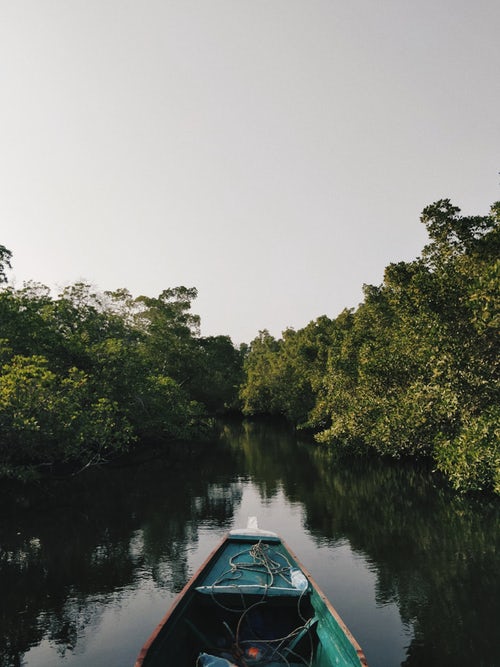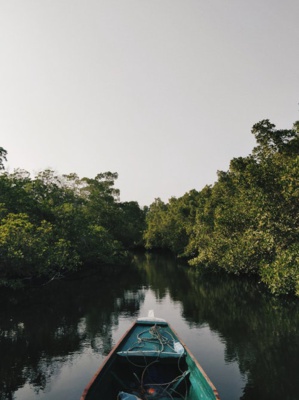Brazilian fishermen like Jose da Cruz have been earning his living for over decades by hunting crab among the country’s vast “coastal mangrove forests”. Cruz is known by his nickname, Vampire due to “his distinctive teeth”.
He doesn’t use any rod or net to catch his prey instead he wades through “tangle of mangroves” and digs out the crabs from the murk with “his hands”. As he progresses, caked with mud, he slowly blends into the surroundings, while his capture amounts to “four or five dozen” in a day which will fetch him “about 200 reais ($50) per week”. This is just enough to “get by”.
However, his lifelong occupation is under threat as the climate is faced with “rapid alteration” and Cruz’s daily catch has been reduced by fifty percent in comparison to the numbers that he would catch a decade ago. Cruz informed that the waterline seems to has “advanced 3 meters inland”.
In fact, Cruz is aware of global warming, as he was said:
“Nature is upset. ... In Antarctica, it’s melting, nature is melting. People, you have to have some awareness about what is happening. It’s clear what is happening.”
Climate scientists have vetted Cruz’s interpretation and said his observations are in scientific line as rising level of the sea is a “sign of global warming”, while it is accompanied with higher water temperature which claims some of the marine life. As per Reuters:
“Globally, scientists have warned that water temperatures are increasing far faster than expected, which drives rising sea levels. Climate change and human development are putting 1 million species, a large share of which live in marine environments, at risk of extinction, according to a report published this year”.
These alarming changes are a threat to many families that are dependent on coastal ecosystem, as low lying coastal, villages such as Cruz’s are “quickly receding under the water”. Carlos Nobre is a climate researcher at the “University of Sao Paulo”, who observed that the water levels have gone up by “20-30 centimetres over the past 100 years in coastal Bahia state”.
Nearly “13,989 square kilometres” of Brazilian coastlines are covered with mangroves which stand as sentinels to guard the world against climate change, thinks “biologist Renato de Almeida”. Comparing one acre of mangrove ecosystem with a similar Amazon rainforest, one would see both the places absorbing an equivalent amount of CO2. While the former acts as an erosion guard. However, the creatures that live within the mangroves ecosystem, like the crabs and oysters, are not as resilient.
And Reuters added:
“Global warming is causing water temperatures to rise, which can kill off crabs and other animals in their food chain if it becomes hotter than the narrow range they are adapted to, Almeida said. Hotter water is also more acidic, which corrodes the shells of crabs and other marine life, he said”.
However, one needs to also keep the reason of overfishing being a significant contributor to the declining crab number. The growth of tourism also affects the mangrove forest, as some of the areas are cleared to make ways for building inns and Cruz said:
“It’s not just here. It’s not just me. There are many fishermen that depend on getting food from the mangroves day-to-day”.
References:
reuters.com
He doesn’t use any rod or net to catch his prey instead he wades through “tangle of mangroves” and digs out the crabs from the murk with “his hands”. As he progresses, caked with mud, he slowly blends into the surroundings, while his capture amounts to “four or five dozen” in a day which will fetch him “about 200 reais ($50) per week”. This is just enough to “get by”.
However, his lifelong occupation is under threat as the climate is faced with “rapid alteration” and Cruz’s daily catch has been reduced by fifty percent in comparison to the numbers that he would catch a decade ago. Cruz informed that the waterline seems to has “advanced 3 meters inland”.
In fact, Cruz is aware of global warming, as he was said:
“Nature is upset. ... In Antarctica, it’s melting, nature is melting. People, you have to have some awareness about what is happening. It’s clear what is happening.”
Climate scientists have vetted Cruz’s interpretation and said his observations are in scientific line as rising level of the sea is a “sign of global warming”, while it is accompanied with higher water temperature which claims some of the marine life. As per Reuters:
“Globally, scientists have warned that water temperatures are increasing far faster than expected, which drives rising sea levels. Climate change and human development are putting 1 million species, a large share of which live in marine environments, at risk of extinction, according to a report published this year”.
These alarming changes are a threat to many families that are dependent on coastal ecosystem, as low lying coastal, villages such as Cruz’s are “quickly receding under the water”. Carlos Nobre is a climate researcher at the “University of Sao Paulo”, who observed that the water levels have gone up by “20-30 centimetres over the past 100 years in coastal Bahia state”.
Nearly “13,989 square kilometres” of Brazilian coastlines are covered with mangroves which stand as sentinels to guard the world against climate change, thinks “biologist Renato de Almeida”. Comparing one acre of mangrove ecosystem with a similar Amazon rainforest, one would see both the places absorbing an equivalent amount of CO2. While the former acts as an erosion guard. However, the creatures that live within the mangroves ecosystem, like the crabs and oysters, are not as resilient.
And Reuters added:
“Global warming is causing water temperatures to rise, which can kill off crabs and other animals in their food chain if it becomes hotter than the narrow range they are adapted to, Almeida said. Hotter water is also more acidic, which corrodes the shells of crabs and other marine life, he said”.
However, one needs to also keep the reason of overfishing being a significant contributor to the declining crab number. The growth of tourism also affects the mangrove forest, as some of the areas are cleared to make ways for building inns and Cruz said:
“It’s not just here. It’s not just me. There are many fishermen that depend on getting food from the mangroves day-to-day”.
References:
reuters.com






